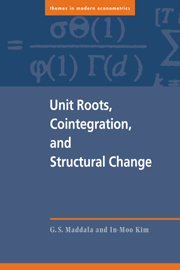Book contents
2 - Basic concepts
Published online by Cambridge University Press: 04 August 2010
Summary
The purpose of this chapter is to introduce several terms that will be used repeatedly in the subsequent chapters, and to explain their meaning. The terms included are: stationarity, ARMA models, integrated variables, Box–Jenkins methods, unit roots, cointegration, deterministic and stochastic trends, spurious regression, spurious periodicity and trend, vector autoregression (VAR) models, and error correction models (ECMs).
Stochastic processes
Prom a theoretical point of view a time series is a collection of random variables {Xt}. Such a collection of random variables ordered in time is called a stochastic process. The word stochastic has a Greek origin and means pertaining to chance. If it is a continuous variable, it is customary to denote the random variable by X(t), and if t is a discrete variable, it is customary to denote them by Xt. An example of continuous random variables X(t) is the recording of an electrocardiogram. Examples of discrete random variables Xt are the data of unemployment, money supply, closing stock prices, and so on. We will be considering discrete processes only, and so we shall use the notation Xt or X(t) interchangeably.
The probability structure of the sequence of random variable {Xt} is determined by the joint distribution of a stochastic process. The question arises, however, since T (time) is commonly an infinite set, whether we need an infinite dimensional distribution to define the probability structure of the stochastic process. Kolmogorov (1933) showed that when the stochastic process satisfies certain regularity conditions the stochastic process can be described by a finite dimensional distribution.
- Type
- Chapter
- Information
- Unit Roots, Cointegration, and Structural Change , pp. 8 - 44Publisher: Cambridge University PressPrint publication year: 1999
- 1
- Cited by



